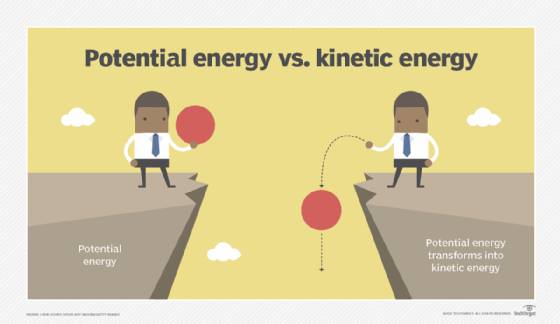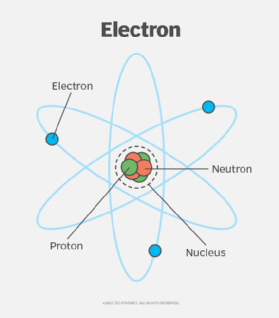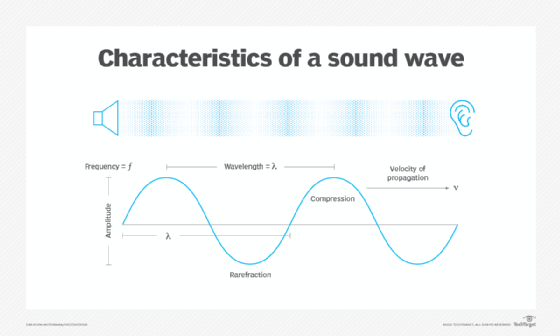kinetic energy
What is kinetic energy?
Kinetic energy is the energy of motion, observable as the movement of an object or subatomic particle. Every moving object and particle have kinetic energy. A person walking, a soaring baseball, a crumb falling from a table and a charged particle in an electric field are all examples of kinetic energy at work. An object that is not moving has zero kinetic energy.
Stationary objects possess potential energy (the other main type of energy). Potential energy is converted to kinetic energy when a force such as gravity acts upon the object to set it in motion. Elastic potential energy, for example, is stored in a stretched rubber band; when the rubber band is released, the stored energy is converted to kinetic energy.
According to the law of conservation of energy, energy cannot be created or destroyed. It can only be converted from one form of energy to another. For example, when a pendulum swings back and forth, it shifts between kinetic and potential energy. At the highest point of the swing, when the pendulum is momentarily stationary, all the energy is potential and there is no kinetic energy. At the lowest point of the swing, the pendulum is moving at its greatest speed, so all the energy is kinetic and there is no potential energy. At any point in a pendulum's swing, the amount of total energy remains a constant as the energy is converted from potential energy to kinetic energy and then back again.

Types of kinetic energy
A pendulum's total amount of energy is considered its mechanical energy. Many of the objects we see on a day-to-day basis possess mechanical energy. Mechanical energy is the sum of an object's potential and kinetic energy. The potential energy might be elastic, chemical, gravitational or in another form. The pendulum is only one example of mechanical energy. Other examples include a person running, a spinning windmill, a flowing river, a satellite orbiting the earth and an apple falling from a tree.
In addition to mechanical energy, there are several other common forms of energy, including the following four types:
- Electrical energy. This is the energy that electrons carry when they travel after they've broken free of their atomic bonds. Electric energy is commonly generated, harnessed, controlled and used in our daily lives, but it can also occur naturally in nature. Examples of electrical energy include lightning, electric eels, brain waves, flashlights, desk lamps and railroad signals.

- Radiant energy. This energy travels through space in electromagnetic waves and particles. Some radiant energy might be in the form of visible light, but it can also include energy such as gamma rays, microwaves or ultraviolet light. Examples of radiant energy are sunlight, radio signals, illuminated lightbulbs, X-ray machines and a toaster's heating elements.
- Thermal energy. Energy that is generated when atoms and molecules move and collide with each other is thermal energy. Although thermal energy is often referred to as heat energy, it can also refer to the thermal state in general, whether warm or cold. Thermal energy varies depending on the atomic activity -- the greater the activity, the warmer the temperatures. Common examples of thermal energy include boiling water, baking bread, geothermal hot springs and the sun warming the atmosphere.
- Sound energy. This type of energy is transferred between particles and moves in waves (vibrations) through a material such as air or water. Sound cannot travel through a vacuum. Not all sound is audible to the human ear, such as frequencies that only certain animals can hear, or frequencies used in equipment such as ultrasound medical devices. Examples of sound include someone singing, hands clapping, the beating of a drum, a buzzing insect and an exploding firecracker.

Measuring kinetic energy
An object's kinetic energy is typically measured in Joules (J) and based on the object's mass (m) and its velocity (v), as shown in the following formula:
The KE represents kinetic energy, although the symbols K, K.E. or Ek might also be used. The velocity is always squared, but the mass is divided by half, indicating that kinetic energy is equal to half of the object's mass multiplied by the velocity squared. The greater the mass and velocity, the greater the kinetic energy.
So, double the velocity and quadruple the kinetic energy. For example, if an object has a mass of 10 kilograms (km) and a velocity of 15 meters per second (m/s), its kinetic energy is 1225 J. However, if you double the velocity to 30 m/s, the kinetic energy climbs to 4500 J. Therefore, a car that collides with a concrete barrier at 20 mph can incur much more damage than a car traveling at 10 mph.
It should be noted, however, that the formula shown here is specific to a type of movement referred to as translational, which is only one of the ways that objects can move. Kinetic movement is often categorized as translational, rotational or vibrational:
- Translational. The object moves along a path from one point to another, such as a train traveling between stations.
- Rotational. The object's motion is centered around a specific axis, such as how the Earth rotates around its axis, or a spoke revolves around its axle.
- Vibrational. The object vibrates, just like a mobile phone vibrates or an atom vibrates, even in a solid.
Some resources categorize kinetic movement as either translational or rotational and omit vibrational. Other resources suggest that there are more than three types of kinetic movement but that these are the primary types. An object can also span multiple types, such as a molecule that has both rotational and vibrational movement.
Kinetic energy is usually calculated differently for nontranslational kinetic movement than it is for translational movement, which is based on mass and velocity. For example, rotational kinetic energy is typically calculated based on the object's moment of inertia and angular velocity.
See also: conductor, wind turbine, polarity, uninterruptible power supply, conservation of angular momentum, angular acceleration, gravitational acceleration, locomotion, matter, gas, solid, plasma and liquid.
